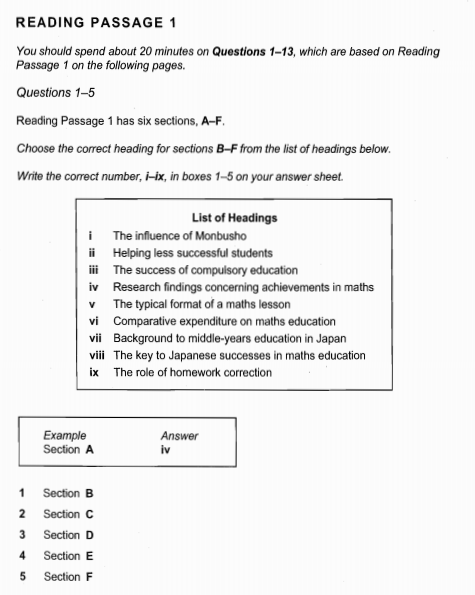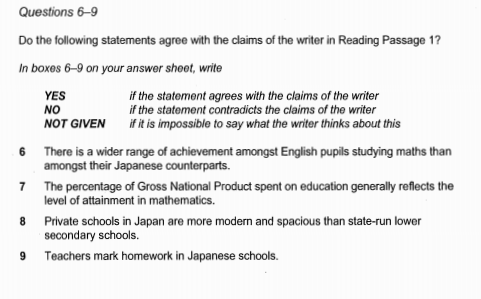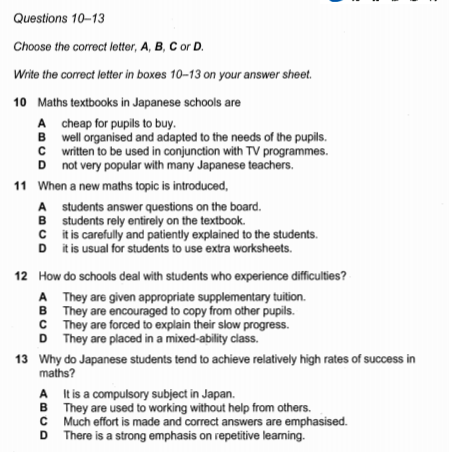剑桥雅思8阅读:Test4雅思阅读PASSAGE1真题+答案+解析
发布时间:2021-01-12 关键词: 
LAND OF THE RISING SUM
A Japan has a significantly better record in terms of average mathematical attainmentthan England and Wales. Large sample international comparisons of pupils'
attainments since the 1960s have established that not only did Japanese pupilsat age 13 have better scores of average attainment, but there was also a largerproportion of 'low' attainers in England, where, incidentally, the variation inattainment scores was much greater. The percentage of Gross National Productspent on education is reasonably similar in the two countries, so how is this higherand more consistent attainment in maths achieved?
B Lower secondary schools in Japan cover three school years, from the seventhgrade (age 13) to the ninth grade (age 15). Virtually al pupils at this stage attendstate schools: only 3 per cent are in the private sector. Schools are usually modernin design, set well back from the road and spacious inside. Classrooms are largeand pupils sit at single desks in rows. Lessons last for a standardised 50 minutesand are always followed by a 10-minute break, which gives the pupils a chance tolet off steam. Teachers begin with a formal address and mutual bowing, and thenconcentrate on whole-class teaching.
Classes are large - usually about 40 - and are unstreamed. Pupils stay in thesame class for all lessons throughout the school and develop considerable classidentity and loyalty. Pupils attend the school in their own neighbourhood, whichin theory removes ranking by school. In practice in Tokyo, because of the relativeconcentration of schools, there is some competition to get into the 'better' school ina particular area.
C Traditional ways of teaching form the basis of the lesson and the remarkably quietclasses take their own notes of the points made and the examples demonstrated.Everyone has their own copy of the textbook supplied by the central educationauthority, Monbusho, as part of the concept of free compulsory education up tothe age of 15. These textbooks are, on the whole, small, presumably inexpensive toproduce, but well set out and logically developed. (One teacher was particularlykeen to introduce colour and pictures into maths textbooks: he felt this would makethem more cessble to pupils brought up in a cartoon culture.) Besides approvingtextbooks, Monbusho also decides the highly centralised national curriculum andhow it is to be delivered.
D Lessons all follow the same pattern. At the beginning, the pupils put solutionsto the homework on the board, then the teachers comment, correct or elaborateas necessary. Pupils mark their own homework: this is an important principle inJapanese schooling as it enables pupils to see where and why they made a mistake,so that these can be avoided in future. No one minds mistakes or ignorance as longas you are prepared to learn from them.
After the homework has been discussed, the teacher explains the topic of
the lesson, slowly and with a lot of repetition and elaboration. Examples aredemonstrated on the board; questions from the textbook are worked through
first with the class, and then the class is set questions from the textbook to
do individually. Only rarely are supplementary worksheets distributed in amaths class. The impression is that the logical nature of the textbooks and their
comprehensive coverage of different types of examples, combined with the relativehomogeneity of the class, renders work sheets unnecessary. At this point, the
teacher would circulate and make sure that all the pupils were coping well.
E ltis remarkable that large, mixed-ability lasses could be kept together for mathsthroughout all their compulsory schooling from 6 to 15. Teachers say that theygive individual help at the end of a lesson or after school, stting extra work ifnecessary. In observed lessons, any strugglers would be assisted by the teacheror quietly seek help from their neighbour. Carefully fostered lass identity makespupils keen to help each other - anyway, it is in their interests since the class
progresses together.
This scarcely seems adequate help to enable slow learners to keep up. However,the Japanese attitude towards education runs along the lines of "if you work hardenough, you can do almost anything. Parents are kept dosely informed of theirchildren's progress and will play a part in helping their children to keep up withclass, sending them to 'Juku' (private evening tuition) if extra help is needed andencouraging them to work harder. It seems to work, at least for 95 per cent of theschool population.
F So what are the major contributing factors in the success of maths teaching?
Clearly, atitudes are important. Education is valued greatly in Japanese culture;maths is recognised as an important compulsory subjecl throughout schooling; andthe emphasis is on hard work coupled with a focus on accuracy.
Other relevant points relate to the supportive attitude of a class towards slower
pupils, the lack of competition within a class, and the positive emphasis on learningfor oneself and improving one's own standard. And the view of repetitively boringlessons and leaming the facts by heart, which is sometimes quoted in relation
to Japanese classes, may be unfair and unjustified. No poor maths lessons wereobserved. They were mainly good and one or two were inspirational.
A 相比英格兰和威尔士,日本平均的数学素养明显有着的纪录。自 1960 年代开始的针对 学生素养的大型国际性样本比较显示,不仅 13 岁的日本学生平均素养更高,而且相比之下, 英格兰的低分学生所占比率更大,得分的差异率也更大。这两个在教育方面的投入占
国内生产总值的比例差不多,为何日本的在数学素养方面得分更高且水平比较一致呢?
B 日本的初中教育是三年,从七年级(13 岁)至九年级(15 岁)。此阶段的学生几乎都是上的 是公立学校,只有百分之三的会选择私立学校。学校的设计通常是现代化的,离公路有段距 离,里面很宽敞。教室很大,学生都是单桌成排。每堂课持续标准式的 50 分钟,之后会有 10 分钟的课间休息让学生放松。先是教师进行正式发言并与学生互相鞠躬致敬,然后集中 精力授课。 教室通常容纳 40 人,不把学生按智力水平分班。学生在同一个教室完成在校期间的所有课 程,并培养重要的集体意识和对集体的忠诚。学生按就近原则择校,理论上学校是不分排名 的。就东京的实际情况来看,由于学校分布相对密集,要进入特定地区的学校是存在竞 争的。
C 课堂采用传统的教学方式,学生上课时很安静,并对要点和举出的例子做笔记。每人都有由 中央教育机构 Monbusho 提供的教科书,这是 15 岁前义务教育的一部分。教科书整体来说 不大,生产费用不高,但是排版清晰,逻辑清楚。(一位教师特别乐意在数学教科书里引入颜 色 和 图 片 ,这 样 可 让 在 卡 通 文 化 背 景 下 长 大 的 学 生 更 容 易 接 受 。)M o n b u s h o 除 了 审 批 教 科 书,还会决定全国高度集中的总课程以及怎样实施。
D 课堂采取同一模式。开始的时候,学生在黑板上解答家庭作业,然后老师会给意见,纠正或 在必要的时候加以详细解说。学生自己批改自己的家庭作业。这是日本教育中很重要的一 个原则,就是使得学生自己发现他们哪里犯错以及为什么会犯错,这样就可以避免再犯类似 错误。没有人介意错误或疏漏,只要你愿意去学。 讨论完家庭作业,教师会慢慢解释那节课的主题,且会重复和详细解释。教师会在黑板上示 范举例,教材上的问题会首先与全体学生一起讨论,然后根据教材设置问题让学生独自解 决。在数学课上极少会分发额外的作业单。教材的逻辑化、全面涉及不同类型的例子以及 学生大概一致的数学水平使得作业单是多余的。这种情况下,老师会巡视学生的作业并确 保所有学生都做得好。
E 一个明显的现象是整个义务教育阶段(从 6 岁到 15 岁),学生的数学课都是在一个大的混合 班上。教师会在课后或放学后给学生单独辅导,必要时布置额外的功课。在实测课时,老师 会对有困难的学生给予辅助,或者学生可向周围的同学私下寻求帮助。注意培养集体意识 使得学生们乐意互相帮助。不管怎样,这关乎他们的利益,因为可集体一起进步。 这样貌似不利于慢学者迎头赶上。但是,日本人对教育的态度一直是“如果你足够努力了, 你就能干任何事”。父母会被频繁地告知孩子的情况,还会在帮助孩子在赶上集体的过程中 发挥作用。如果需要额外帮助的话,父母会送孩子去 Juku(私立夜校)并鼓励孩子更用功 学习。至少对于 95% 的学生来说,这似乎是有用的。
F 那么数学教育成功的主要因素是什么呢?态度是十分重要的。日本文化对教育相当重视, 数学在义务教育中被认为是一门重要的学科,强调学生要努力学习并且在数学问题上要达 到系统。 其他相关方面表明集体对慢学者的支持态度包括:集体竞争并不激烈,积极强调为自己而学 和改善自己的水平。另外,认为日本课堂上就是重复的枯燥的功课,以及死记硬背的观点是 不公平不合理的。日本的数学课没有很差劲的,反倒主要是质量良好的,并且有一两个还是 很有启发性的。


文章结构
体裁:说明文
主要内容:本文主要介绍了日本在数学领域取得的成就以及如何在教育上取得成功。
结构:
Section A :日本和英国相比在数学方面取得的成就。
Section B :日本学校的装饰特点和课程模式。
Section C :介绍了 Monbusho 的影响。
Section D :介绍如何对待作业问题和新课程的传授。
Section E :如何帮助后进学生。
Section F :获得数学教育成功的因素。
师资点题剑桥雅思8阅读:
考题解析
Questions 1-5
● 题型归类 :List of Headings
题目解析
题目编号 题目选项句意 段落主题句 题解
1 vii 日本中学 教育的背景 Section B 个小段落的首句 Lower secondary schools in Japan cover three school years ... 答案 vii Section B 重点介绍了日本中学的 一个基本情况,其主题句就在个小段 落的段首,比较容易找到。
2 i Monbush 的 影响 本段第 2 句话 答案 i 本段着重介绍了 Monbusho 并 对其展开说明。本段的第 2 句话引出了 Monbusho 这个概念,后面则重点介绍了 Monbusho 对日本数学教育带来的影响。
3 v 数学课的典 型模式 Section D 个小段落的首句 Lessons all follow the same pattern. 答案 v Section D 介绍了家庭作业以及新 课的授课形式。其中个小段落的首句 话为主题句,点明了课程遵循一个相同的 模式,之后则具体阐述了这个模式是如何 运转的。
4 ii 帮助不太成 功的学生 Teachers say 答案 ii Section E 重点说明教师如何帮助 后进学生。其中,小段的第 2 句以及 第二小段的首句为主题句,介绍了老师给 予单独辅导使后进学生能够跟上课程。
that they give individual help at the end of a lesson or after school, setting extra work if necessary.
This scarcely seems adequate help to enable slow learners to keep up.
5 viii 日本在数 学教育上取得 成功的关键 小段的首句和 第2句 答案 viii Section F 重点说明了如何在数学 教学上取得成功。本段首句和 2 句为主题 句,介绍了态度是决定成功的关键性因素。
师资点题剑桥雅思8阅读:
考题解析
Questions 6-9
● 题型归类 :YES/NO/NOT GIVEN
题目编号 题目定位词 题目句意 题解
6 English pupils, Japanese counterparts 学习数学的英国 的小孩比日本的 小孩在成绩方面 有更宽的区间。 YES 原文重现 A 段的第 2 句话。题 目中说在学习数学的英国小孩比日本 小孩在成绩方面有更宽的区间,文章 中原句的意思是和日本孩子相比,英 国孩子成绩方面的可变性区间更大, greater 和 wider 属于同义替换。
7 Gross National product, percentage 通常花在教育上 钱 所 占 GNP 的 比率反映了取得 数学成就的水平。 NO 根据定位词找到A段最后一句话。 题目说通常花在教育上钱所占 GNP 的 比率反映了取得数学成就的水平,文 章却说在两个花在教育上的钱是 相似的,而日本取得了更高的成就, 题目与文章内容矛盾。
8 private schools, state-run lower secondary schools 日本的私立学校 比公立学校更现 代化、更宽敞。 NOT GIVEN 此题考查了对 Section B 的理解,原文中没有涉及题目中所提 到的信息。
9 teacher, homework 在日本的学校, 老师批改家庭作 业。 NO 根据定位词找到 Section D 小 段的第 3 行。题目说在在日本的学校 老师批改家庭作业,而文章说孩子们 自己批改作业,题目与文章内容相矛 盾。
师资点题剑桥雅思8阅读:
考题解析
Questions 10-13
● 题型归类 :Multiple Choice
题目解析
题目编号 题目关键词 原文定位 题解
10 maths textbooks, Japanese schools C 段第 3 句话 答案 B 题目问日本学校的数学教科书如何。 文 章 中 说 the textbook are...well set out and logically developed, B 选项意思是“合理安排并 且适应学生的需求“,符合文意。
11 new maths topic Section D 第 二小段首句 答案 C 题目问怎么样介绍一个新课题,文 章 中 说 ...the teacher explains the topic of the lesson, slowly and with a lot of repetition and elaboration,C 选项意思是“十分仔细和耐心 地去给学生解释”,与原文意思相符。
12 experience difficulties Section E 第 一小段第 2 句 答案 A 题目问学校如何帮助遇到困难的学 生,对此文章中说 Teachers say that they give individual help at the end of a lesson or after school, setting extra work if necessary,A 选 项 意思是“学生被给予合适的额外的补课”,所以 为正确答案。
13 relatively high rates of success Section F 第 一小段末句 答案 C 题目问为什么日本学生能在数学上取 得比较高的成绩,文章中说 Education is valued greatly in Japanese culture, maths is recognized as an important compulsory subject throughout schooling, and the emphasis is on hard work coupled with a focus on accuracy, C 选项意思是
“做出努力并对正确答案加以强调”,符合 文意。




